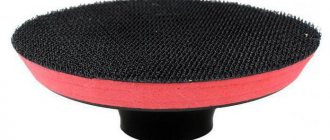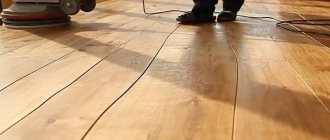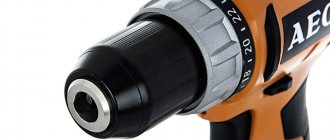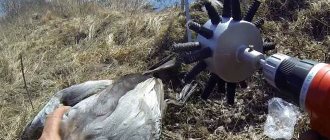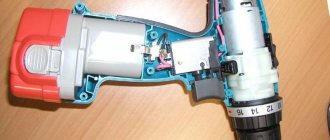Scheme and principle of operation
Structurally, any belt grinding machine consists of the following elements:
- Electrical engine;
- pulley with fixed straight roller;
- tension rollers;
- rotary clamping mechanism;
- abrasive tape;
- base.
To expand the functionality of the unit, individual designs have additional elements that allow work with heavily contaminated or deeply corroded surfaces. In this case, an abrasive disc is installed on the motor drive shaft.
A homemade grinder is assembled according to a similar scheme as a professional one.
The basic principle of operation of such a grinding machine is to drive the abrasive belt using a roller system.
It consists of a main video, which is the leading one. It is fixed to the motor shaft. The remaining rollers are secondary or driven. They have an adjustment mechanism that allows you to change the tension of the tape. To change the angle of inclination, the grinder has an adjustment mechanism.
The engine for the grinder is selected based on the list of work that is planned to be performed, productivity and degree of load. The industrial version is equipped with an engine designed in accordance with the specified parameters. It allows you to obtain the required belt speed, as well as uninterrupted operation for a long time. The value of this parameter is determined by the engine shaft speed and the size of the pulley. The most optimal belt speed is considered to be about 30 m/sec. To simplify obtaining the necessary parameters, a summary table has been developed. With its help, you can find the desired belt speed depending on the speed of the selected engine. It can be accurately calculated using known formulas and table data.
In modern literature and Internet portals you can find drawings with dimensions of various grinder designs. When choosing the layout and design of a future device, you need to evaluate your capabilities for purchasing or manufacturing each element of such a unit. For example, what kind of electric motor is planned to be used. Determine the required dimensions of the entire product. What type of tape do you plan to use in your work?
From the Bulgarian
The simplest and most common design is the grinder made from an angle grinder. The motor and electrical control circuit located on the grinding machine are used as the basis. To set the abrasive belt in motion, a special nozzle is made. It consists of two shafts and a fastening system. The grinder for angle grinders is an additional accessory. To assemble a grinder from an angle grinder with your own hands, you need to make individual structural elements yourself.
Ready-made structures can be found from 125 angle grinders. They are installed on the grinder, creating a belt mechanism for using a standard abrasive belt. The horizontal mechanism allows you to provide the necessary characteristics of the grinder.
How to make a drill attachment (polishing wheel) for car polishing with your own hands
If the owner of a car wants the surface of his steel horse to shine brightly, he needs to polish the body. You can perform this procedure at home. It requires a special polishing wheel for the drill and the electric tool itself.
The most common products for processing automobile bodies are: sponge-like, abrasive with varying degrees of grain, felt, having a soft surface. They are conventionally classified according to the type of production into two types:
- petal (has high productivity and high price);
- surface grinding (made like a rubber disc with an additional coating for processing).
The material for these items is dense foam rubber or felt, which has different diameters. However, kits are sold that consist of several elements that have different purposes and manufacturing complexity.
Grinders from Rustam
The most common model is GR-1. They are equipped with two types of motors: single-phase or three-phase. The grinder from Rustam has a 1.1 kW motor. This power is quite enough to provide the necessary characteristics. The developed design uses rollers that are coated with a layer of propylene. This significantly reduces noise levels and reduces heat during rotation.
The original design of the rotary table allows processing of parts of various geometric shapes.
With a washing machine motor
The main element of grinding machines is the engine. It can be selected independently from other electrical appliances. One option is a homemade grinder with a washing machine engine. The use of such a motor requires the creation of a reliable frame and a fastening system for all elements.
READ How to Convert a 220V Cordless Screwdriver
They make a finished unit from a washing machine motor with their own hands, having previously calculated the rotation speed of the belt. This can be done by knowing its characteristics: engine power and speed. If the rotation speed is too high, it is necessary to develop an electronic engine control system.
Usually, to simplify the task, they use the engine of a small washing machine. This greatly simplifies the task of making a grinder with your own hands. Such grinders are made to fit a standard belt size of 75 mm wide and 475 mm long.
Bonding tape
Modern manufacturers of abrasive materials offer ready-to-use belts. They can be in rolls of a given size or glued into a ring. Usually there is a need to make an abrasive belt for a grinder to specific sizes. This is done by gluing strips to a specific size. To solve this problem you will need the following materials:
- tape for gluing abrasive materials;
- glue;
- degreasing liquid (gasoline or white spirit);
- a clamp or weight for compressing glued parts.
- Mark the strip of abrasive along its length, taking into account the joint, which is made at an angle. The larger it is, the longer the contact length.
- The backing of the required length is cut out of the braid. It ensures reliable gluing.
- The surfaces are prepared for applying glue: they are cleaned with sandpaper and degreased.
- Cover the substrate and part of the tape with glue.
- Gently press the substrate against the abrasive tape and fasten them together using the available tools.
If the gluing is done carefully, the homemade tape will last quite a long time. In terms of its consumer characteristics, it will be no worse than the samples produced at the enterprise.
Lefty
Belt grinder Leftsha 610 belongs to the category of professional machines. It operates from a three-phase 380 V or two-phase 220 V network. Possessing a rotating bed that can be rotated 90°, it allows processing of workpieces of various shapes. Grinder Levsha 610 provides a belt rotation speed of 15 m/s. This belt grinder is equipped with a 1.1 kW motor. It provides a rotation speed of 3000 rpm.
The manufacturer offers several modifications of its products: 610pro, mg 610a, Lefty 1250. Each of the listed models has its own design features. For example, the grinder Master 610 is designed to use a belt 610 mm long. Grinders from the company Mosgrinder have similar characteristics.
Do-it-yourself Velcro sanding disc
If you often do construction and finishing work, then you probably have to clean any surfaces very often. It is no secret that this is done with ordinary sandpaper, which becomes unusable in a very short time. If you compare the price of one sheet of sandpaper and a circle with Velcro, the price will be exactly the same, only the circle has a diameter of 12 centimeters, and the leaf is three times larger than this circle.
READ Chainsaw Partner 371 Chrome DIY Repair
Watch the video on how to make three Velcro discs from a sheet of sandpaper
For work we will need: - 1 round disk purchased; - a sheet of sandpaper of standard size; - double sided tape; - scissors.
We need a base to which we will attach sandpaper and tape.
Then we take double-sided tape and cut off a large piece, which we glue to the very center of our circle. The tape needs to be very, very sticky, otherwise it won't hold.
Now we cut off about 8 small pieces of tape and glue them around the perimeter.
Now remove the protective film from the tape.
We take our sheet of sandpaper and turn it over with the rough side facing the table surface.
We glue our workpiece into the very corner of the sandpaper. Be sure to glue it in the very corner, otherwise we will waste a lot of sandpaper in vain. Now let's cut this whole thing out.
The disc is almost ready, only the very last ones remain. This is to make holes in the disk. To make holes, take a drill and any wood drill.
Now we put any piece of wood on the table, put it in reverse on the drill and start making holes.
Our sanding disc is ready, now you can attach it to the machine and use it.
Of the minuses, although there is only one, it is there. You need to make the discs yourself and spend your time and energy on it.
Our handmade grinding machine is ready! If you follow all the instructions described above, you will get a real friend and assistant who will rightfully take its rightful place in the workshop.
How to make a petal disk yourself
Browse products for inventors. Link to the store.
I found the prototype on the Internet, on the “I Build It” website. First we will make a template for the petals. Let's cut a small piece from the finished plinth and transfer its profile to a piece of plywood 4 mm thick. Then we will cut out and sand a template with which we will mark the sheet of sandpaper. Now we will make a drum from this board. But first, let's mark the workpiece. Let's draw a circle with a diameter of 65 mm and divide it into 24 equal parts. Let's draw another circle with a diameter of 55 mm. It will determine the depth of the cuts. Now use a ring drill to cut out two disks and glue them together. The drum is ready. Its thickness is about 0.5 cm.
DIY electronics in a Chinese store.
While the glue dries, let's make the petals. Using the template, mark the sanding paper and cut out the petals of the future disk. Using the markings, we will make shallow radial cuts. Lubricating the flat edge of the petals with “liquid nails” glue, insert it into the drum. The glue had dried by then.
Let's assemble the grinding disc. Insert an M6 screw into it and tighten it with a nut.
Tools and materials
Tools:
- Angle grinder with cutting discs.
- Drill and drill bits.
- Wrenches for 11, 12 and 19.
- Lathe.
- Vise.
- Electric motor (6 A minimum, or 12 A recommended).
- Various bearings.
- Nuts, bolts, washers, lock washers of various sizes.
- Metal corner.
- Sanding belt 20 cm.
- 10 cm pulleys.
- Powerful spring.
- Steel strip 4 x 20 cm.
- Beam 2.5 x 10 x 10 cm made of wood or MDF.
Frame manufacturing and installation
It is important to mention that using a metal corner as a frame can have both advantages and disadvantages. The obvious advantage is that it is convenient to assemble, like a construction set in childhood. But the main drawback is that it is strong only in two directions, but weak when twisted. This means that we need to take this weakness into account and calculate what torque can be transmitted from the pulleys to the frame, and compensate for it using additional jumpers.
Cutting: You can use a hacksaw to cut the angle, but an angle grinder with a cutting disc will make the job faster. After cutting all the pieces, I would recommend sanding down all the sharp edges to avoid cutting yourself during assembly. The holes can be drilled using a conventional drill and cutting fluid.
Checking the makeshift disk
Fine dust flies and sands poorly. The paper is too soft. She just strokes the workpiece. The marks from the saw blade remain, albeit slightly smoothed. It turns out that such a disc is not suitable for rough grinding. Let's try using sanding paper on a fabric basis. She's tougher. We will also make the length of the petals shorter. The template profile has also changed a bit. I’ve already done it, because when you touch the part, the petals bend.
I recently became the owner of a band saw. So making cuts in the drum has become much easier. I filled the drum with petals in the same way as before.
Over time, the glue had dried, so to get to the glue that had not dried, I had to cut the tube. Let's check. There are effects. More noticeable than when using the previous disk, but not enough. It will be faster to remove marks from the saw blade manually. Flap sanding discs are used for final sanding. A negative result is also a result. Maybe you can tell me what's wrong.
DIY wood sanding machine
Grinding machine, a useful thing in the workshop. For those who work with wood, such a device is a must-have, as it is universal, which greatly simplifies the work. But, unfortunately, such machines are quite expensive and therefore have to be invented. This article will talk about a functional, and most importantly convenient, grinding machine, with detailed drawings and photos. Each point is discussed in detail, and if something is not clear, you can always watch the video.
READ Petrol cutter Stihl Ts 420 Fuel consumption
Dimensions
Here is a table with the overall dimensions of our homemade tool:
| Parameter | Value, mm |
| Length | 365 |
| Height | 400 |
| Width | 230 |
Dimensions of walls and adjacent elements:
Bracket element dimensions:
Dimensions of handles and driven rollers: Dimensions of table top: Dimensions of base:
Main video
The main roller is the most important part of the project, as it receives torque from the motor and transmits it to the belt. I used an old bushing to secure it, but I recommend using a bearing instead. The bushings do their job, but they constantly overheat and require regular lubrication. Moreover, they can scatter dirty lubricant, which can be annoying during operation.
Shaft: There are threads on the sides of the shaft with different directions so that the mounting bolts do not unscrew when rotating. If you cut off one threaded side like I did, leave the one that goes counterclockwise, otherwise you'll have to make a locking bolt (I'll describe how to make that later) and a cotter pin. The main pulley will be placed on the cut edge.
Pulley: Continuing with the theme of reuse, I found an old pulley from another project. Unfortunately, I prepared it for the threaded pin that it was supposed to be held on, but, in fact, this is not a problem. I made a rectangular cutout in this pulley. I then used an angle grinder to cut a groove on the end of the shaft. By placing the key in the hole formed by the shaft groove and the rectangular cutout of the pulley, I securely fixed them relative to each other.
DIY abrasive wheel.
First, I’ll briefly go through the points, if you don’t change your mind, then I’ll write in detail. I'm afraid I won't manage this evening 
1. Circle - cylinder Approximately f200 x 30 width - maximum. I plan to add a profile later - this is how it is always done.
Yeah that's good. The straight profile is the easiest to manufacture.
that's good. The straight profile is the easiest to manufacture.
Press form. For small volumes, the mold undergoes maintenance for at least 45 units. In case of increasing the volume of the mold, it is advisable to chrome plate it followed by grinding. The durability of the chrome plated mold is approximately 150-200 pressings.
2. I planned to try regular garnet sand, which is sold for sandblasting. In our area it’s not so easy to buy what you need, and it’s cheap.
You need to be careful with the components. If you want to have a predictable result, then it is better to work on one or two types of abrasive. Preferably a factory-made abrasive with the required dispersion and constant chemical composition (a quality certificate is desirable, but not required). It is better to refrain from abrasive, which is shoveled into bags in a nearby quarry. Using the correct basic components (abrasive and bond) will prevent damage to nerve cells in the future. 
3. I don't know. That's why I created the topic. I was thinking of trying some kind of glue - if they suggest, or a polymer melt. The bond should be soft, sand that wood (also soft)
This is ambiguous. The main requirement for the bond is to “correctly” hold the abrasive. Grinding occurs due to wear of the abrasive, and not due to the bond. The bond can enhance or weaken the effect of the abrasive. For example, a tool on ceramics and FFS. The characteristics of the tool are the same. But after grinding with a tool based on FFS, the surface will be cleaner, because... The resin has a slight polishing effect.
I tried an ordinary stone with silicon carbide - green - so it started instantly - and that’s it (((.
Most likely, the circle was solid with low porosity
4. There is a press, What is a thermostat in relation to the situation? Something to heat and control - I have... - a set of heaters of different shapes and an Aries controller for them.
When using a binder that does not require heating (epoxy resin, liquid glass), the question of a thermostat disappears by itself. When using binders made of thermoplastics and thermosets, you will need a stove that allows you to reach a temperature of 200 ° C. When using phenol-formaldehyde resins (bakelite, FFS), the accuracy of maintaining temperature throughout the entire volume of the oven should be plus or minus 2-3 degrees. When using thermosets (FFS), a finished unreinforced circle can be obtained, as a rule, in two ways: cold pressing and hot pressing. In the first case, a sample of the mechanical mixture of components is loaded into a mold and pressed. The workpiece is removed from the mold and placed in an oven for curing. In the second case, a sample of the mixture is loaded into a mold and pressed on a press equipped with heating plates. After a certain time, the finished product is removed from the mold. Having tried hot pressing, I almost immediately abandoned it and completely switched to cold pressing.
5. I have never heard of domestic circles for this purpose, and GOST for them. Imported ones have their own markings, which do not carry any meaning for me like CL CLR CB CS.
Anyway. If there were some initial data, it would be possible to immediately narrow down the search and development circle. But even so you can make some kind of technical specification for yourself. 
6. 5-10 laps every month. Impossible to say as longevity is unknown.
Before starting the conversation here, I talked with sellers of such products. It's difficult to get a clear answer. You need to try and try.
If you seriously want to make circles, then it will take some time to perfect the technology.
Necessity at work and at home
Today, grinding machines are used constantly in production shops. Depending on the scale of production, either one machine or all its varieties in complexity and size can be installed.
However, there is always a use for this equipment in everyday life. Some people have a bench sanding machine for metal processing in their garage. Others have several wood grinding machines of different designs installed in their workshop. Still others own a universal, combined machine. There are power tools for manual grinding: drum type, belt grinder, band saw, small machines or large machines. And they are all in demand.
The market offers a fairly wide range of all kinds of similar equipment from many manufacturers. And their prices are quite reasonable. But these are general purpose machines. And if a person runs his own business, or has a hobby, then he needs a specially specialized machine. Here the price has already increased several times.
For this reason, or based on their own desires, many craftsmen make homemade products. Mainly for processing wood, plastic and metal, less often for cutting and grinding stone. And, in general, this is correct. After all, even simple sharpening of kitchen knives is easier and faster to do on a machine than by hand using a whetstone. Fortunately, its very simple design allows you to create a homemade machine for wood with your own hands.
Sources:
https://usamodelkina.ru/2811-nazhdachnyy-disk-na-lipuchke-svoimi-rukami.html https://intehstroy-spb.ru/stanki/kak-sdelat-shlifoval-nyy-stanok-po-derevu-svoimi -rukami.html
